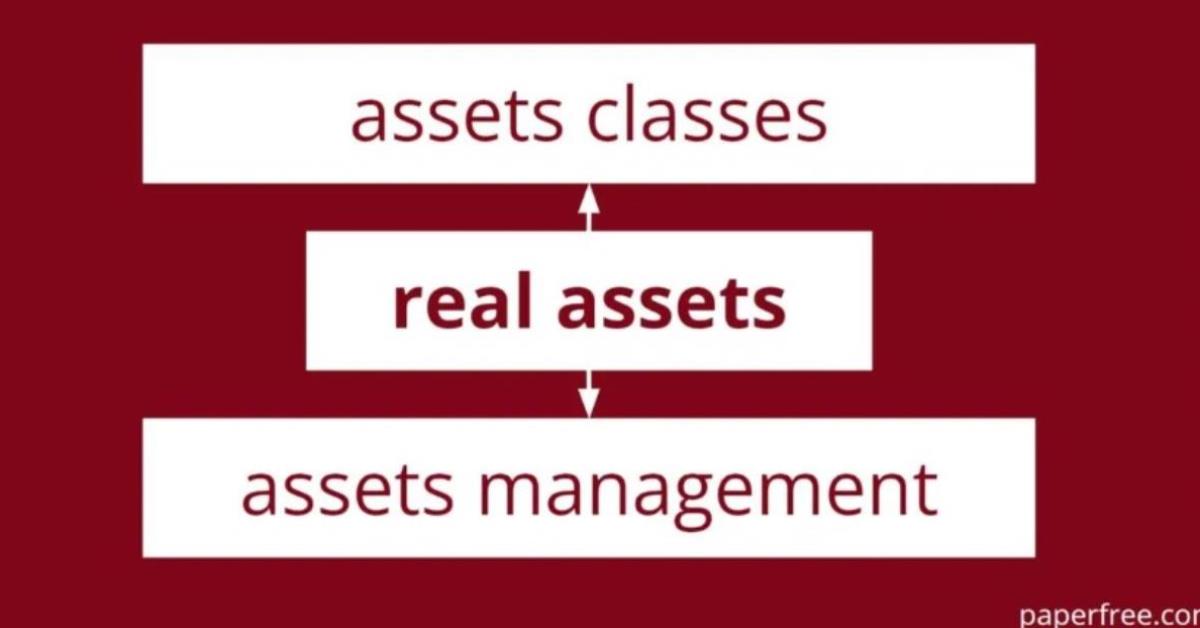Exploring Real Assets: Real Estate and Infrastructure Guide by Paperfree.com
Explore real assets: real estate,infrastructure, commodities with Paperfree.com. Discover how these investments can add stability and growth to your portfolio.last updated Wednesday, December 31, 2025
#real assets #what are real assets
|
|
by John Burson by Sidra Jabeen |
Content Manager, Paperfree Magazine Content Manager, Paperfree Magazine |

QUICK LINKS
AD
Get Access to Real Estate Investment Opportunities
The demand for real assets has increased in recent years and will continue to grow as investors better understand this asset class's positive attributes.
Key Takeaways:
-
- Definition of Real Assets
- Real assets serve as a nontraditional source of income.
- Real assets are a tool for investment portfolio diversification.
- Investing in real assets offers inflation hedging.
- Investing in RA drives competitive total returns.
What are assets?
There are three main asset types: real, intangible, and financial. All assets have a value that can be converted to cash.
.jpg)
fig1. What are assets?
- Real assets.
Real assets are an investment asset class that backs investments in physical assets. They differ from other assets because they have a physical presence and can deliver direct, tangible results. Real assets can be natural resources, such as gold or oil. They can also be human-made things like infrastructure, machinery, and buildings. - Intangible assets.
Intangible assets don't have physical properties. For example, patents, trademarks, copyrights, brand identity, and intellectual property are intangible assets. - Financial assets.
Financial assets are property attached to a contractual right or ownership claim. Examples of financial assets include stocks, bonds, mutual funds, bank deposits, investment accounts, and cash. Additionally, financial assets such as hard currency may appear in physical form. Or they may exist nonphysically, like a money market account.
What are real assets?
.jpg)
fig2. What are real assets?
Real assets classes
Real assets refer to foundations and resources that support everyday activity in society and the world economy. While numerous investments could be considered real assets, our definition includes the following.
- Real estate.
Property types include land, apartments, offices, warehouses, malls, and other commercial or retail properties. Real estate Investment vehicles include real estate investment trusts (REITs), private real estate funds, and syndicates. - Infrastructure.
Infrastructure comprises the fundamental frameworks and facilities that support society, organizations, and businesses. It is essential for transportation, commerce, housing, goods distribution, and many other vital processes. Infrastructure includes toll roads, pipelines, airports, bridges, roads, and cellphone towers. - Commodities.
Commodities are natural resources, including oil, natural gas, precious metals, gold, corn, pigs, and soybeans.
What is the Difference Between Real Assets vs. Financial Assets?
Although tangible assets are tangible, they differ significantly from financial assets. The primary difference is that real assets hold value from their physical properties. In contrast, financial assets retain value as contractual claims on an underlying asset, whether real or intangible.
This chart shows that commodities and property are real assets. Still, commodity futures, exchange-traded funds (ETFs), and real estate investment trusts (REITs) are financial assets that depend on these underlying real assets.
Many people conflate these two asset categories, misunderstanding their relationship. ETFs, for example, can invest in companies involved in using, selling, or mining real assets, or track the price movements of a specific real asset or a basket of real assets. Either way, the EFTs' earning power depends on the appreciation of the underlying real assets.
Some of the most popular ETFs in the world by volume hold value from underlying real assets, such as
- State Street's SPDR Gold Shares (GLD)
- iShares Silver Trust (SLV)
Both ETFs invest in precious metals and track their performance.
Technically, these ETFs are financial assets, and the physical gold or silver bullion they hold is the underlying asset.
Pros and Cons of Real Assets
Pros of real assets
In 2017, Brookfield, an asset management firm, revealed that real assets, equities, had a total global value of $5.6 trillion. Of this total, 57% were natural resources, 23% were real estate, and 20% were infrastructure. These are some primary reasons real assets tend to have high investment value.
- Portfolio diversification.
Real assets help diversify portfolios because they negatively correlate to financial assets like stocks or bonds, meaning the two asset prices move in opposite directions. In the same 2017 report on real assets, Brookfield noted that older real assets tend to increase in value as replacement costs and operational efficiency rise over time. - Inflation hedge.
Real assets are typically more stable than their counterparts. They are also better assets during inflationary periods, currency value shifts, and other macroeconomic factors. Real assets are particularly well-suited for inflationary times because they historically outperform financial assets during such periods. - Less Risky Than Similar Asset Classes.
This asset class has fared better than other riskier asset classes during inflation and economic downturns. Under most circumstances, a real asset will likely recover from a severe drop in fair market value (FMV). On the other hand, stocks representing ownership stakes in a company could become worthless, or a corporation can default on its bond obligations. Of course, the value of real assets can fluctuate considerably during recessions, but there is typically a specific dollar amount of value tied to the asset at all times. For example, real assets underwent a steep devaluation during the 2008 housing crisis. Fortunately, the crisis was temporary, and home prices slowly recovered, but a significant number of financial assets saw far more volatility, and many could not withstand the market crash. - Good Diversification.
Given the historically low correlation between equities and bond markets, real assets can protect your portfolio against unexpected downturns. As a result, they provide more diversification by improving a portfolio's risk-adjusted returns. - Income stream.
Cash flow from real assets like infrastructure projects and real estate can produce predictable and steady income streams for investors. These assets generate revenue through financial entitlements, such as rental agreements, royalty rights, land use rights, and drilling rights.
Cons of real assets investment
Real assets, like other asset categories and classes, have disadvantages. Here are the most challenging ones.
- Illiquidity.
Since they take longer to sell, real assets have lower liquidity than financial assets. Real assets also have higher transaction fees, including legal, taxes, and transfer fees. Also, it is challenging to assess the value of some real assets. This issue could bog down or postpone an asset sale, especially if you don't get your desired valuation. - Storage fees.
Real assets have high carrying and storage costs. For example, physical gold bullion requires storage in third-party storage facilities, which charge monthly rental fees and insurance. - Limited passive investment options.
Financial assets like mutual funds and ETFs allow you to invest passively in real assets. However, passive investment options are rare for real assets. For example, a real estate offer requires active management from the owner. You could get stuck dealing with tenant issues, property maintenance, and other property management duties. - Higher capital requirements.
The initial investment for acquiring real assets can be very high. And there are usually ongoing capital contributions for expenses, such as maintenance, property taxes, insurance, and other operational costs. Acquiring real assets, such as real estate, often requires a substantial initial investment and ongoing expenses for maintenance, property taxes, insurance, and more. This high capital requirement can be a severe barrier to entry for many investors.
What is an example of real asset investment?
A group of Florida investors pooled their money and purchased a 30-story office building in Orlando's Central Business District near Lake Eola Park. On the date of purchase, the office building was 95% occupied by business professionals with stellar histories of on-time monthly rental payments.

fig3. Example of real asset investment - office building
The structure of the ownership was a limited liability company (LLC). This property required active management, including:
- Maintenance,
- leasing vacant space,
- and dealing with tenant-related issues.
Since these investors had joined forces before, they agreed to hire a property management company they'd used.
Although the property yields lucrative rental income, the investment group planned to exit the investment in five years with a property sale. They aimed to get a total annual return of 11%. A standard metric for assessing total return is the Capitalization Rate (Cap Rate). A lower Cap Rate on the exit from investment typically suggests a potentially better return.
The average deal size for Orlando's Central Business District increased by 11% from September 2022 to September 2023 [3].
Real estate asset management
Real estate asset management refers to overseeing and maximizing the value of real assets on behalf of individuals, organizations, or institutions. A well-managed real estate asset increases the potential to generate returns over time. On the other hand, a poorly managed property loses its ability to generate returns and becomes a net expense. PwC forecasts that alternative asset classes will double in size by 2025. This trend indicates the growing importance of asset management.
How Does Real Estate Asset Management Work?
Real estate asset management encompasses processes designed to enhance the market value of real estate investments.
Here is a list of the essential real estate management processes:
- Planning
Constructing sound financial plans. - Sourcing
Sourcing real estate investments. - Strategy development
Analyzing real estate investment assets to develop effective economic strategies that mitigate risk exposure. - Cost optimization
Reducing operational, maintenance, and closing costs. - Income optimization
Improving existing revenue streams and income. - Risk management
Forecasting and mitigating associated risks.
Who is an asset manager?
An asset manager oversees assets on behalf of someone else, making important investment decisions that will help the client's portfolio grow. An asset manager also ensures the client's investment doesn't depreciate and mitigates the client's risk exposure. Doing this means watching the market, keeping up to date with research and monitoring trends, and staying current with political, financial, and economic news.
An Asset Manager's Role in the Real Estate Industry
Real estate asset managers serve the same function as asset managers of other financial assets. They concentrate on optimizing a property's value to achieve investment goals. However, you shouldn't confuse them with real estate property managers because they are not involved in the daily operations of a property.
Infrastructure asset management
What Is Infrastructure?
Infrastructure is the framework that supports the basic physical systems of a company, region, or nation. It often involves the production of public goods or production processes.
What are infrastructure assets?
Infrastructure assets are long-lived capital assets/property, typically stationary and preservable for a significantly greater number of years than most capital assets. Infrastructure assets are the basic facilities and systems serving a country, region, or community.
Some of the key characteristics of infrastructure assets are:
- Large-scale infrastructure is produced by the public sector and funded by tax revenue.
- Small-scale infrastructure is produced by private firms or through local authorities.
- Infrastructure is classified as soft and hard.
- Infrastructure is essential to the economy and quality of life of a society.
There are two main types of infrastructure: soft and hard. Soft infrastructure represents personnel and institutions necessary to maintain an economy that delivers certain services to the population. Hard infrastructure is the physical system needed to run a modern, industrialized nation.
What are examples of infrastructure assets?
.jpg)
Examples of infrastructure assets include:
- Roads
- Bridges
- Tunnels
- Drainage systems
- Water and sewer systems
- Dams
- Lighting systems
What are the costs of infrastructure assets?
The capitalized costs include the purchase price (or construction cost) and the related expenses incurred more than necessary to place the asset in its intended location and in a condition where it is ready for use.
The associated costs include:
- Professional fees of engineers
- Attorneys fees
- Appraisers
- Financial advisors fees
- Survey fees
- Appraisal and negotiation fees
- Damage payments
- Site preparation costs
- Costs related to the demolition of unwanted structures
Land associated with an infrastructure asset must be reported separately as land. Buildings associated with infrastructure should be reported as buildings unless they are purely related to an infrastructure network or system (e.g., rest area facilities for a state highway or water pumping stations associated with water systems).
The Role of Infrastructure Asset Management in Sustainable Economic Development.
Infrastructure assets will expand more than fivefold
Video 1. Infrastructure asset management role in a sustainable recovery from COVID-19
PwC foresees robust growth in real assets, primarily in infrastructure and, to a lesser extent, real estate. From 2016 to 2020, PwC predicted a 27.5% per annum growth rate in infrastructure. It projects infrastructure assets will increase more than fivefold, from $0.6 trillion in 2016 to $3.4 trillion in 2025.
Conclusions
Technology will impact every aspect of asset and wealth management.
Asset managers need a keen eye for the technological developments driving exponential change. Machine learning and AI will change how investors conduct research and portfolio management, and Robotic Process Automation will revolutionize the back and middle office. At the same time, blockchain could profoundly impact the services industry. They must design new products and services that meet changing needs. This vital social role is also why regulators worldwide ensure that fees are fair and advice is sound.
Real estate asset management services allow investors to access professional investor expertise. It allows individual investors to invest passively in real estate because an experienced team of asset managers manages their assets.
Paperfree.com is one of the leading real estate asset management services. Please keep reading to learn how teams like ours care for the life cycle of your investment, from origination to disposition.
Sources
[1] Get real with income-producing real assets https://www.nuveen.com/en-us/insights/fixed-income/get-real-with-income-producing-real-assets
[2] Asset Managers in the Real Estate Market https://www.investopedia.com/ask/answers/040815/what-does-asset-management-mean-regards-real-estate.asp
[3] Orlando Tenants Are Attracted to Quality Office Space as Rental Rates Rise https://rebusinessonline.com/orlando-tenants-are-attracted-to-quality-office-space-as-rental-rates-rise/
Pages Related to #real assets
- How to Spot and Avoid Hard Money Scams

- 5 Common Mistakes to Avoid When Investing in Real Estate

- Are You Paying Too Much for a Real Estate Investment Property?

- The Lender Checklist: Finding a Solid Real Estate Investment

- 3 Types of Bad Credit Commercial Hard Money Lenders

- Non institutional lenders are taking the center stage

- Real Estate Investment Principles by Bruce Flatt the CEO of Brookfield Asset Management

- 5 Best Ways to Invest in Real Estate For Starters

Popular Page
Private Real Estate Funds - Investments to Drive Income and Capital Growth
Book a Free Complimentary Call
Search within Paperfree.com
real estate investing Investment Visa USA Investment Magazine Private Real Estate Funds real estate funds
